C.S. Burrough's Blog, page 8
December 6, 2024
My review of Women I've Undressed: A Memoir, by Orry-Kelly
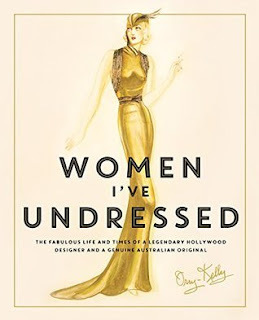
Orry-Kelly was a name synonymous, in old Hollywood, withOscar winning costumes and career-long close working affiliations with iconslike Bette Davis, Katharine Hepburn, Olivia de Havilland, Barbara Stanwyck, AvaGardner, Kay Francis, Dolores del Río, Ann Sheridan and Merle Oberon.
A plucky gay kid from the New South Wales township of Kiama,he was born in 1897 and sent to Sydney at seventeen to study banking. Defyinghis parents' plan for a respectable career, he instead became a small-timestage actor.
Using the great city Down Under as a springboard to thewider world, he landed in New York earning a crust however he could: paintingscenery, wheeling and dealing, blocking handmade ties, getting nowhere on stagebut sharing crumby rooms and friendships with other struggling performers, someto become legends, others fading into obscurity.
Here he established friendships with upcoming or newlyestablished Broadway headliners like Fanny Brice, George Burns and Mae West. Healso took under his wing the nay too talented but fast-learning youngEnglishman Archie Leach, later carved into legend as heart throb CaryGrant.
Having almost inadvertently landed on his feet as acostumier, with zero training or qualifications, he grabbed an offer inHollywood in 1932 and stayed, we assume abandoning his own ambition ofperforming, knowing a good thing when he was onto it.
He was Warner Bros' chief costume designer until 1944, laterdesigning for Universal, RKO, 20th Century Fox, and MGM. He also spent a stintin the US Army Air Corps in WWII before being discharged with alcohol issues.
Kelly's stylistic instinct defied the lure of glitter andsequins we associate with Hollywood's golden age, instead going firmly withunderstated elegance, gaining him the unswerving loyalty of great leadingladies who knew a good thing when they wore it on screen.
With "networking" a phrase long yet to be coined,Kelly's "who-you-know" personal survival technique resulted in closelifelong bonds with the likes of Ethel Barrymore and their ilk. We sense himsniffing out the influential and using a blend of sycophancy and craftyhaggling to forge vital allegiances.
His movies included classics like 42nd Street, TheMaltese Falcon, Casablanca, Arsenic and Old Lace, Harvey, Oklahoma!, AuntieMame, and Some Like It Hot.
By the late 1950s and early 1960s, with several hundredmovies under his belt, power dynamics had reversed, and he became an authorityto be reckoned with, famously dressing down Marilyn Monroe after one of heron-set flare ups.
A chronic alcoholic, he died of liver cancer in 1964, aged65, and was interred in the Hollywood Hills. His pallbearers included CaryGrant, Tony Curtis, Billy Wilder and George Cukor and his eulogy was read byJack L. Warner
His unpublished memoir was found by a relative, in apillowslip, where it had stayed until half a century after his death, whenGillian Armstrong's TV documentary on him, Women He's Undressed,triggered its erstwhile unlikely unveiling.
Some argue the piece had never been published because of hisopen sexuality being too taboo at the time of its penning, with othersinsisting his priceless anecdotes would have insulted too many esteemedHollywood insiders.
I sense that a more accurate explanation is its unfinishedcondition. Yes, he had reached the end of his tale in this raw draught he leftus, but the work is far from crafted to the finished state such a perfectionistwould have required. He indeed opens with a thinly veiled disclaimer along thelines of 'people say I talk in circles', admitting, towards the end, of alsohaving hired a ghost writer to rework it, but having thrown away that product,which he believed entirely erased his personality.
Whatever the reason, I find it inconceivable he would havewanted this to be the draft we all read, hence it being hidden away for solong. A character as determined as he would have seen it published in hislifetime had he thought it ready for print. Whilst his flighty personalityremains indelibly intact here, this glowing authenticity is the price of hisnarrative being, for the most part, an impenetrable and irritating rant,skipping back and forth like the proverbial twittering budgerigar. This tipsy dinner-partytype rambling, with its apparent petty score-settling, I despaired of.
Though it took every ounce of patience not to throw thehefty item across the room, I persevered, purely to devour each last goldenanecdote. For although an award-winning designer does not a great writer make,here is a fidgety but irresistible raconteur whose priceless content faroutweighs his tacky, exasperating style.
The superb photographic content is sadly misplaced, insetamong a brash and flippant page design I despised, with its nauseatinglycoloured chapter graphics quite at odds with the understated style of Kelly'sfamous costumes (though perfectly as one with his brassy, undisciplineddialogue). The cumbersome dimensions of the 432-page, 7.7 x 1.7 x 9.4-inchhardback is like trying to hold up an oversized stone house brick to thebedside lamp. I recommend the Kindle or audio editions for all but professionalweightlifters.
Not a person I could bear to sit long with, Kelly's storiesnevertheless deserve such preservation, despite their raffish form. I only wishmore editing had been utilised for such an important book, to neaten things upand inject readability; but then considering it was published in 2015, so manydecades after the narrator's demise, one must appreciate the impossibility ofconsultation with him over such matters.
For Australians interested in their national history thereare fascinating and extensive passages on early twentieth century Sydney,including the brothels and backstreets of Darlinghurst.
Imperative reading for those drawn to behind-the-scenesHollywood, here is a time capsule of inestimable value for any showbizhistorian. Just conjure up every last ounce of patience for the precariouslyskittish and roundabout manner of storytelling.
Highly recommended if you live well with the longwindedchaos of the otherwise supremely talented.
My review of Theatre, by W. Somerset Maugham
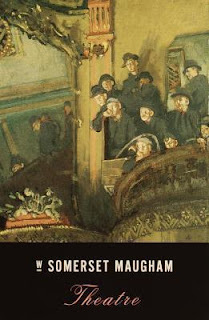
After relishing Of Human Bondage, penned 22years before this and adapted into a career-defining Bette Davis movie, I wassurprised on several levels by Theatre, whose 2004 screen adaptionscored Annette Bening a Best Actress Golden Globe and an Oscar nominationfor Being Julia.
Firstly, I was surprised by its great readability, of thekind that defies conventional analysis; that literary X-factor distinguishinggreat writers from good ones, their material striking an artful balance betweenadequacy and audacity.
Secondly, I was surprised that Theatre's magicis not in its delivery, which is clunky for such a successful wordsmith (he hadthis published in 1937, forty years after his breakthrough novel, Lizaof Lambeth). Nor is his command of vocabulary so apparent here, as wasnoted by contemporary critics, several of whom were unimpressed by this novel.
Thirdly, I was surprised to see that word economy was notone of Theatre's notable stylistic features. Maugham's evolvedindifference to narrative refinement suggests publication teams had become shyof engaging with this giant. Nor is the style, conversely, so flamboyant.
Perhaps he had simply come to hold less concern for formthan his less prolific contemporaries, more confidence in the purity of hisstorytelling. This is strangely reassuring.
Those first three questions collectively begged the fourthand ultimate one for me: how did he get away with being so blasé?
I believe the answer is that, like so many prolific mastersof the era, Maugham had relaxed into his art sufficiently not to need to provemuch anymore. This piece might never have kick started his career, decadesbefore; his vast readership had simply, by 1937, developed a steady appetitefor whatever he wrote.
The essence of this fiction lies in its bare substance,rather than its presentation. As such, Theatre defies thediscerning reader's better judgement by refusing to be put down despiteconspicuous imperfections. Its key strength lies in the authenticcharacterisation, most notably that of protagonist Julia Lambert.
Perhaps a crucial ingredient is its triggering of thereader's speculation as to which of this novelist-playwright's countlessactress friends Julia Lambert parodies – not that she is a mere parody; on thecontrary, here is a finely nuanced and compellingly original heroine. Maughamwas famously friends with the likes of Gladys Cooper and Ethel Barrymore, toname but a couple, which lures the inquisitive mind down intriguing paths.
I devoured this roughly crafted gem like afamished hyena and shan't hesitate to reread it down the track.
My review of Marlene Dietrich, by Maria Riva
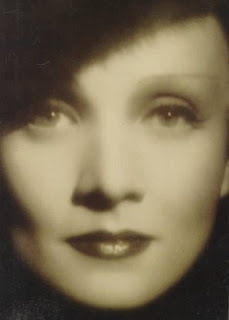
I had to read this account of the woman seen through herdaughter's eyes. I knew this was no trashy Mommie Dearest act of vengeance,having pored over mainstream reviews. I found Maria Riva's efforts commendable.Marlene was something else, onscreen and off. Imagine a night on the tiles withher, Berlin, circa 1920-something.
Born in 1901 in Schöneberg, now a district of Berlin, Dietrich studied violin,becoming interested in theatre and poetry as a teenager. Her first job, in1922, was playing violin in a pit orchestra accompanying silent films. She wasfired after four weeks.
She instead became a chorus girl, touring with vaudeville-style revues. Alsoplaying small roles in dramas, she initially attracted no special attention.Her film debut comprised a bit part in The Little Napoleon (1923).By the late 1920s, Dietrich was playing sizable screen roles.
In 1929 came her breakthrough role of cabaret singer Lola Lola in TheBlue Angel (1930), which introduced her signature song 'Falling inLove Again'. A success, she moved to the U.S. for Paramount Pictures as aGerman answer to MGM's Swedish Greta Garbo. The rest, as they say, is legend.
In 1999, the American Film Institute named Dietrich the ninth-greatest femalestar of all time. Among my favourites of her films were Witness for theProsecution and Stage Fright. Marlene's middle years wereof great interest to this baby boomer:
Approached by the Nazis to return to Germany, she famously turned them downflat. Staunchly anti-Nazi, she became an American citizen in 1939. Dietrichbecame one of the first celebrities to raise war bonds. She toured the US formost of 1942 and 1943, reportedly selling more bonds than any other star.
During 1944 and 1945, she performed for Allied troops in Algeria, Italy,Britain and France, entering Germany with Generals Gavin and Patton. When askedwhy she did so despite the obvious dangers, she replied, 'aus Anstand' ('out ofdecency').
Awarded the US Medal of Freedom in 1945, she said this was her proudestaccomplishment. She was also awarded the French government's Légion d'honneurfor her wartime work.
Dietrich performed on Broadway twice in the late 1960s, winning a special TonyAward in 1968. In 1972 she received $250,000 to film I Wish You Love,a version of her Broadway show An Evening with Marlene Dietrich, inLondon. Unhappy with the result, she need not have been.
I have live recordings of her 1960s and 1970s concerts, and what a performershe was. She had no need to sing as such; she was simply a supreme artiste whoheld audiences around the planet mesmerised.
In her later years, Dietrich's health declined. She survived cervical cancerand suffered from poor leg circulation. A 1973 stage fall injured her leftthigh, requiring skin grafts.
'Do you think this is glamorous?' she said in a 1973 interview. 'That it's agreat life and that I do it for my health? Well it isn't. Maybe once, but notnow.'
After fracturing her right leg in 1974, her live performance career largelyended when the following year she again fell off stage, this time in Sydney,Australia, breaking her thigh.
Her last film appearance was a cameo role in Just a Gigolo (1979),starring David Bowie, in which she sang the title song. That same year herautobiography, Nehmt nur mein Leben (Take Just My Life), was published.
Dependent on painkillers and alcohol, Dietrich withdrew to the seclusion of herParis apartment to spend her dotage mostly bedridden. For more than a decadeshe became a prolific letter-writer and phone-caller, before dying aged 90 in1992.
It is perhaps unnecessary to hear from Maria Riva about her mother's manyaffairs and sexual fetishes. Fortunately, this does not lower the book's tone,just pads it out needlessly. That is my only criticism.
A good, solid documentation of a screen legend's ways by her frank and not atall nasty daughter.
My review of Gypsy: Memoirs of America's Most Celebrated Stripper, by Gypsy Rose Lee
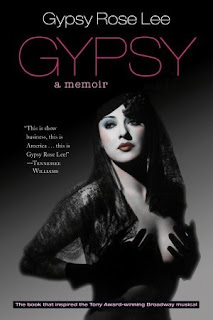
This 1957 memoir follows the early life of Ellen JuneHovick a.k.a. Rose Louise Hovick, alias Gypsy Rose Lee, who became a legend inher lifetime.
The author was older sister of later Hollywood actressJune Havoc. The pair began in Vaudeville as toddlers, managed under thetutelage of their mother. Baby June was the cute headliner with gawky Rose inthe lineup, the latter often in boys' clothes or a pantomime cow's rear end.When the maturing June deserted the act, Rose stepped out of the cow's behindand into the spotlight, becoming Gypsy. She became an icon of big-timeburlesque, as vaudeville outran its course and the options narrowed – she hadto do something, with mouths to feed and a mother who had kept her from anyschooling. Showbiz was all Rose had ever known when she made this fatalistictransition.
She was a self-made lady, a raconteur, an entertainer ofthe highest order. Of the many (purportedly self-generated) myths about thisoriginal queen of reinvention, the greatest was that generated by the mists oftime – that she was just a stripper. No such thing, she instead tastefullyremoved and discarded the odd glove, stocking or feather, shifting emphasisonto the 'tease' in striptease.
Also an actress, author, playwright and radio talk host,Gypsy turned her talents in many directions. She was a formidable intellect,admired collector of rare objets d'art and antiques, widely read, conversant ona glorious array of cultural topics and one of the best dressed women in thepublic eye. A renowned philanthropist, she gave generously to and supported avast range of worthy causes.
Herein lies the inspiration behind Sondheim's blockbusterstage and screen musical Gypsy, considered by many the greatestAmerican musical ever. Adaptations famously showcased a gorgeous young NatalieWood in the 1962 movie's title role. As Gypsy's archetypal overbearing stagemother, Mama Rose, starred the wondrous Rosalind Russell, scoring the GoldenGlobe Award for Best Actress. Russell's role, earlier created onstage by 'brassdiva' Ethel Merman, who won the 1959 Tony Award, became one of theatre's mostcoveted. Stage revivals have seen subsequent 'Mamas' Angela Lansbury, PattiLapone and Bernadette Peters reap award after award.
This is a gorgeously written, marvellously entertainingread from a woman with a heart of gold and the sheer, glittering class ofshowbiz royalty. I adored reading her anecdotes in this delicious memoir, neverwanting to put it down and making excuses for early nights with her.
Someone threw away the mold when this fabulouslady was made.
My review of The Forsyte Saga, by John Galsworthy

This is for me the definitive period saga, by NobelPrize-winning John Galsworthy. The reader follows the intertwined characters'lives for many years and several generations, with the collection comprisingthree hefty novels breaking down into five volumes:
The Man of Property (1906)
Indian Summer of a Forsyte (1918)
In Chancery (1920)
Awakening (1920)
To Let (1921)
Almost everyone I've known had seen this before reading it,including my great-grandparents. Two silent film adaptations, 1921 and 1922,captivated some Galsworthy devotees but attracted erstwhile print-shy masseswho became converts, running out in droves to buy the cumbersome books.
Similarly, a high calibre 2002-3 miniseries starring GinaMcKee and Damian Lewis, with an endearingly wrinkly Wendy Craig, proved asatisfying recreation for some author fans but a watchable inspiration for thenew millennium's page-reluctant youth, hoards becoming seduced into reading it,fuelling a modern-day sales resurgence.
My own adolescent introduction to this extensive fictionalfamily was via the classic 1967 TV adaptation with a cherubic young MichaelYork, the then stellar Nyree Dawn Porter, pretty ingénue Susan Hampshire andthe all-accomplishing Margaret Tyzack (featuring, as Smither, the wondrous lateMaggie Jones who would later win British hearts as Coronation Street'sacerbic-tongued, gallows-humoresque Blanche Hunt).
The saga concerns the trials and tribulations of atwin-pronged nouveau riche British family, whose not so distant forbears werefarmers. The author's own 'new money' upper-class family was not unlike thisfictional one he so meticulously chronicles. The materially acquisitiveprotagonist, solicitor Soames Forsyte, is incurably unfulfilled despite hisever-expanding assets and status, his heart remaining shattered over first wifeIrene.
Soames' rival cousin, painter Young Jolyon, who is actuallyolder than Soames, was originally the family's favourite until deserting hiswife for their daughter's governess, forever since thumbing his nose atsociety. The latter, however, subsequently remarries Soames' ex-wife, Irene,concreting their cousinly enmity.
Themes threading these volumes together include those commonto the historic family saga genre: blood feuding, changing generations,mortality, ambition and duty versus desire.
There was something about the older Forsytes I found moreendearing, their often-comical arch snobbery, their handwringing at not havingquite yet reached that 'old money' mark, their whacky foibles, quirkyprejudices and neurotic manifestations of status anxiety.
The younger generations, as the saga progresses, have lessedge, having mostly seen the errors of their forebears' ways and adapted forthe 'better' (making them blander all round). They also represent the laterperiod, as we compare them to their elders and their new epoch to times past.This characteristic is necessitated by the very concept of family saga. Itdemonstrates the loosening of restraint; the attitudinal progress time brings.
That necessity of genre notwithstanding, it is the veryeccentricities, queerness and glaring shortcomings of the older, earlierForsytes that makes them such colourful reading subjects (as was the case withthose earlier penned, unforgettable characters of Dickens and other greatnineteenth century masters from which Galswworthy's style seemingly drawsconsiderable inspiration).
Unlike some great sagas, this one never departs from Englishsociety's upper strata to glimpse the characters' lower-class counterparts,reminding us, perhaps, of the author's somewhat stifled cloistered upbringing.As if offsetting that limitation, there is sufficient of the 'downstairs' (thetimeless, classless, primal) in some of these multidimensional, magnificentlydrawn 'upstairs' characters, whose humaneness at times transcends the abstractof class. Though they are all, superficially, defined by their staunch socialstatus, we are frequently reminded of that humble, if ambitious, farmers' bloodstill coursing through their not yet fully gentrified veins. This paradoxicaledge to the Forsytes is charming, sometimes laughable, sometimes sad but makesthem always accessible to us, the reader.
It took me many months, with breaks between volumes but,having selected it as midwinter bedtime reading, I remained blissfullyunhurried about the mammoth task. Was often unable to put it down and switchoff the bedside lamp, getting in 'just another quick chapter before I nod off'then noticing the dawn glimmering in through the blinds. I was left feelingnauseatingly smug as I closed the final page of the final book.
By no means a quick, easy or lazy read, this detailed bodyof work demands intense focus or continuity evaporates. The mental investment,however, is worth the rewards, as we end up on intimate terms with a remarkablefamily. If you love historical sagas, The Forsyte Saga isconsidered by aficionados to be the original, the ultimate one of its kind.This is something you will have seriously missed out on if the effort is notmade. A magnificent work from a master storyteller.
My review of Mary Queen of Scots and the Murder of Lord Darnley, by Alison Weir
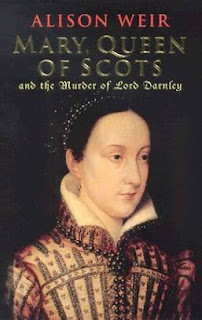
Alison Weir surpassed herself penning this tome, the firstin my opinion to rival Antonia Fraser's 1969 Mary Queen of Scots.Via Mary Stuart runs the continuous line of succession, from Plantagenets &Tudors, down to England's current royals.
Mary has always polarised debate, first when alive and then,through the centuries, from the grave. Regardless which account we accept, shecannot be seen as entirely blameless for her unfortunate life. It's also beyondquestion that too much blinkered blame has gone her way, backwards in time.
Her murdered second husband Henry, Lord Darnley, was a hideous character whoarguably deserved his comeuppance. If Mary was privy to his murder plot, we canhardly blame her. It's an equally short-sighted assumption that anyone put inMary's position would not have conspired towards her liberty when so unjustlyimprisoned for so long by Queen Elizabeth I. She was viciously provoked, set upand entrapped into her 'treason' against Elizabeth.
Mary Stuart, great-niece of England's King Henry VIII, was 6 days old when herfather, King James V of Scotland, died and she acceded to his throne. UnitingFrance and Scotland against conflict with Henry VIII's England, France's KingHenry II negotiated little Mary's marriage to his three-year-old son, theDauphin Francis. Five-year-old Mary was shipped to France and spent thirteenyears at the French royal court.
Despite that regal upbringing largely moulding her character, Mary's detractorscriticise her limited grasp of her native Scottish subjects who were then,largely, backwater bog and highland dwellers. Yet this eventually anointedqueen of France had not seen Scotland since being spirited away as an infant.
Widowed at eighteen, Mary was no longer wanted in the French court by hermother-in-law, France's new regent, Catherine de Medici. Though she could haveretired there in splendour, remarrying any prince in Christendom, Mary insteadreturned to her homeland to start anew.
In vain she reached out to her surly Scottish subjects who, after ceremonialformalities, snubbed her as a high-flying foreigner. They eyed her withsuspicion from the minute she disembarked in her mourning garb, a grown womanand stranger. They considered this newly arrived Catholic head of state, intheir Protestant land, anomalous. This sentiment was fuelled by Protestantreformist preacher John Knox, who vehemently campaigned against Mary.
Worse still, she was female.
Across the border, her less beautiful but wilier cousin, Elizabeth, remainedcontentiously unwed. Resentful of Mary's youth and fecundity, the childlessElizabeth also felt threatened by Mary's strong claim to England's shakythrone.
After two more short and unpopular marriages, Mary was overthrown andimprisoned in Scotland. Eventually escaping, she shaved her head for disguise,donned peasant's clothing and fled, by fishing boat, to England. Hoping forElizabeth's support, Mary was instead imprisoned and held captive foreighteen-and-a-half years.
After despairingly plotting towards her liberty (making herself complicit inlinked plots for Elizabeth's assassination), Mary was entrapped and executed.This unprecedented regicide officially triggered the Spanish Armada. CatholicPhilip of Spain had been waiting for an excuse to take England and curb thespread of Protestantism in Europe. As was her final wish, Mary became aCatholic martyr.
Mary's apologists argue she was a kind, intelligent woman, a romantic icon ofher day. She was indeed the subject of sonnet and pros, by Ronsard no less. Herbeauty and personal charm are legendary.
Neither her cruellest detractors nor most ardent apologists are fully right orwrong. The truth, as always, lies somewhere in the middle. This is where AlisonWeir's insightful, brilliantly researched and presented account places it.
The reader is left with a balanced understanding of events while empathisingwith, and recognising the obvious mistakes of, a desperate woman. I loved thisbook and reread it to reabsorb the literary quality and exquisite detail.
My review of Wait for Me! by Deborah Mitford
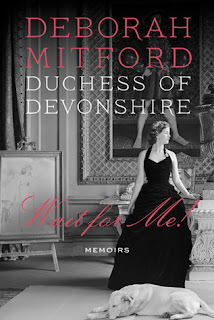
For Mitford sisters' fans, Deborah is essential reading.The youngest, she achieved the highest rank, as Duchess of Devonshire. She wastoo young to know the earlier Mitford households, Batsford House then AsthallManor, which were mythologised as 'Alconleigh' by sister Nancy in thebestselling semi-autobiographical novel The Pursuit of Love.
Instead, Deborah grew up at Swinbrook, which their fatherbuilt and the older Mitford girls despised due to its lack of historic charm orcommunal library (which had been most of their autodidactic bedrock).
In some ways therefore a standalone, Deborah lacked hersiblings' unfulfilled yearnings for formal education, instead relishing herrural childhood and many animals. She loved horse riding and many of herfather's country interests, which the others (except for 2nd eldest Pam) longedto escape.
Perhaps because of these adored formative years, she wasarguably the most well-adjusted Mitford girl and was noted for always treatingpeople of every social stratum equally.
When She married Lord Andrew Cavendish, younger son ofthe 10th Duke of Devonshire, in 1941, there was no thought of him inheritingthe dukedom, the couple living in various bucolic settings on the fringes ofher in-laws' estates. She otherwise went around England with her army husband,whose military pay was pretty ordinary.
Only when Andrew's older brother William, Marquess ofHartington, was killed in action in 1944 did he unexpectedly become heir. WhenAndrew became the 11th Duke of Devonshire on his father death in 1950, Deborahwas a Duchess!
Post-war inheritance taxes of 80% approx. (a bill of £7million or £220 million in 2016) meant selling off much of the vast Dukedom ofDevonshire estate to pay for retaining the jewel in its crown, historicChatsworth House.
As the new Duchess, Deborah faced the mammoth task ofrestoring Chatsworth, for centuries the Cavendish family seat, which would opento the public to pay for its upkeep. From scratch she learned to restore andmaintain one of Britain's foremost stately homes, becoming the face ofChatsworth for decades, at times manning Chatsworth's ticket office herself.
These projects later extended to other heritage listedsites in the estate. In those restorative arts, and in running a stately home,she became an expert, writing around a dozen books on Chatsworth itself, plusnumerous works of personal memoir. In 1999, she was appointed a Dame Commanderof the Royal Victorian Order (DCVO) by Queen Elizabeth II, for her service tothe Royal Collection Trust.
She became Dowager Duchess on her husband's death in 2004and died herself in 2014 aged 94, the last surviving Mitford sister.
Her memoir Wait for me! takes its titlefrom her being the youngest and therefore the last in early family outings andactivities, always running behind trying to catch up on her tiny young legs.Her teasing eldest sister Nancy always said down to earth Deborah had retainedthe mental age of an eight- or nine-year-old, never acquiring the airs andgraces expected of a grand duchess. Of course, this was Nancy's way with all.
Deborah (nicknamed 'Debo' from an early age) entertainedand befriended everyone of world importance, from the Kennedys in the '50s and'60s to Prince Charles and Camilla in the new millennium, yet always had somesmall anecdote about even the humblest servant.
This striking humility, with her gratitude for the goodfortune she enjoyed (and quiet stoicism over the losses of three of her sevenbabies), makes her writing immediate and engaging. Like most of her famoussisters, she had a natural talent for writing and storytelling and was a trueeccentric, at strokes fascinating, moving and hilarious.
Not the fanciest Mitford sister, the wittiest or thearchest, Debo is the most solid and grounded of those published. Herphotographs from over the decades, from angelic infancy to tulle and diamantebedecked debutante, to hostess of twentieth century world leaders, arebreathtaking.
Of all Debo's books, this one in particular is the icingon the cake for any Mitford canon devotee. She does not disappoint!
My review of Lady in Waiting: My Extraordinary Life in the Shadow of the Crown, by Anne Glenconner
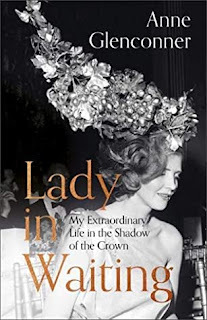
LadyGlenconner's life could arguably not have failed to make unputdownable reading.One might think it impossible for any aristocratic wife of the owner of theisland of Mustique, and royal Lady-in-Waiting, to get this wrong, consideringreadership thirst. Yet being a prominent peeress and socialite does not alwaysa fine author make. Some other daughter of an earl may not have been blessedwith this one's magnetic persona or storytelling prowess. Whilst she humblyacknowledges the publisher's support, this articulate and amusing woman is aborn raconteuse.
Her words glow with the impish charm and wry wit reminiscent of the late greatNancy Mitford, another highborn Mistress of Anecdote whose work became anindustry. Literary critic Raymond Mortimer wrote that Mitford's Madame dePompadour "reads as if an enchantingly clever woman was pouring out thestory to me on the telephone." In Glenconner's Lady in Waiting wefind a similar flair. As with Mitford's globally loved works, Lady Anne'snarrative makes no stab at literary greatness, instead riding on candour andauthenticity guaranteed to entertain.
Her breathtakingly privileged status never once becomes the storytellingliability it could have, in connecting with everyday people. Her frankness andhumility win us onside, without an ounce of the pomposity that has been theundoing of some biographers of her rank.
That we can't help but empathise over some of the awfulness life has thrown ather, is testimony to the balance of this piece. Her starchy aristocratic fatherThomas Coke, 5th Earl of Leicester, her impossible but fabulous husband ColinTennant, 3rd Baron Glennconner, her adored yet tragic two sons the Hon. Henryand Charles Tennant, were never going to make Lady Anne's life a walk in thepark. But fabulous times she has enjoyed, and she shares these generously withher readers, taking us on the ride of our lives.
Having anticipated this finely polished biography for a year, I drank it up infour nights and was saddened to close the last page.
A classy and delicious read. More please, Lady G.
November 12, 2024
My review of The Mitfords: Letters Between Six Sisters, by Charlotte Mosley (Editor)
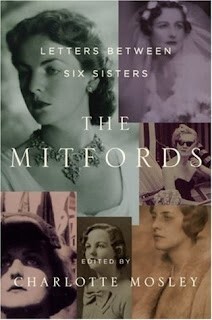
'I also think a volume of letters will have to wait until everyone's dead, don't you, because of hurt feelings?' Diana to Deborah, 17 August 1980.
Such was this potential 834 page can of worms, comprising just an estimated five per cent of the sisters' letters, yet effectively telling six interrelated life stories: the daughters of David Freeman-Mitford, 2nd Baron Redesdale and his wife Sydney Bowles (Sydney's father founded English Vanity Fair and The Lady magazines, employing son-in-law David to manage The Lady).
The Mitford saga lends credence to the adage 'truth is stranger than fiction'. You couldn't invent such tales. Hardly a week went by in the 1930s without one of this sextet making headlines.
The opening letters, from 24 July 1925, show the interwar halcyon years, the English country lives of the Mitford girls. Mainly home-educated by governesses, most are well read thanks to their grandfather Algernon Freeman-Mitford's legacy which included a stately family library.
Debutante of 1922 and Bright Young Thing Nancy is 20, flitting to and from her London and Oxford social scenes. Pamela is 17, Diana 15, Unity 10 and Jessica 7. Little Deborah is just 2, her first letters not appearing here until she approaches her tenth birthday in 1930.
To subsidise her father's tight allowance, Nancy starts writing, encouraged by literary amigo Evelyn Waugh. Initially uncredited in society gossip columns, she then sells signed articles, until in 1930 The Lady gives her a regular column (presumably helped by family connections). She soon attempts novels, basing characters on relatives, friends and acquaintances.
If Nancy's literary enterprise is a gamble, her love life is a fiasco. She is soon ditched after a futile lengthy engagement to effeminate gay aesthete Hamish St Clair Erskine, four years her junior, second son of the 5th Earl of Rosslyn and ex-lover of her brother Tom. On the rebound, she is engaged to erratic Peter Rodd, second son of Sir Rennell Rodd the soon-to-be ennobled Baron Rennell. The marriage will become largely a sham.
But Nancy's exploits are eclipsed by the younger Diana, who in 1929 wins over her naysaying parents and marries brewing heir Bryan Guinness who will inherit the barony of Moyne. Such a great society beauty is she that family friend James Lees-Milne calls her 'the nearest thing to Botticelli's Venus that I have ever seen'. Evelyn Waugh dedicates his novel Vile Bodies, a satire of the Roaring Twenties, to Diana and Bryan. Her portrait gets painted by Augustus John, Pavel Tchelitchew and Henry Lamb.
Diana triggers scandal in 1932 by leaving her husband for British Union of Fascists (BUF) head Sir Oswald Mosley. As Mosley does not intend leaving his wife 'Cimmie' (Lady Cynthia Curzon, daughter of Lord Curzon, former Viceroy of India) Diana lives in a flat as his mistress, until in 1933 Cimmie dies of peritonitis.
With Unity along for the ride, Diana then ingratiates herself with Adolph Hitler's circle on Mosley's covert bidding for a commercial radio station on German soil to fund Mosley's BUF. In 1936 Diana and Mosley secretly marry in Joseph Goebbels' Berlin house, with Hitler a guest. Unity is meanwhile swept away, a Hitler devotee and Third Reich fanatic, basing herself in Germany much of the time.
In 1937 teenage Jessica, the 'red sheep' of the family, having long saved to run away, elopes to Spain with second cousin Esmond Romilly, Communist nephew of Winston Churchill. Romilly finds work reporting for the News Chronicle and, after legal obstacles caused by their parents' opposition, they marry and move to London, in the poor industrial East End.
On 20 December 1937 Jessica has a baby, Julia, who dies the following May in a measles epidemic. In 1939 Jessica and Esmond emigrate to the USA. When WWII starts Esmond enlists in the Royal Canadian Air Force, leaving Jessica in Washington D.C. carrying another daughter, Constancia. After a bombing raid over Germany, Esmond goes missing in action on 30 November 1941.
Nancy meanwhile discovers in the summer of 1938 she is pregnant but miscarries. In early 1939 she joins her husband Peter Rodd in the South of France as a relief worker, assisting Spanish refugees fleeing Franco's armies in the civil war. Soon afterwards Rodd, commissioned into the Welsh Guards, departs overseas and Nancy, back in London, has her second miscarriage.
The early war years are gruelling for all, except maybe Pamela who always took life in her stride. She has married the brilliant 'rampantly bisexual' scientist and heir to the News of the World Derek Jackson (becoming the second of Jackson's six wives). From around now too, relations between Jessica and Diana permanently freeze, their political rift so deep it becomes personal.
On 29 June 1940 Diana, prised from eleven-week-old Max Mosley, is interned without charge in Holloway Prison under Defence Regulation 18b, a dangerous person to the state, tagged 'England's most hated woman'. With Mosley already interned separately in Brixton Prison, Diana pines for her husband and four sons (two from each marriage). The couple reunite in Holloway in December 1941, lodged in a flat on prison grounds, thanks to Mitford cousin-in-law Prime Minister Winston Churchill. Both are released in November 1943, on grounds of Mosley's ill health, and placed under house arrest until war's end at Mosley's Crux Easton property in Berkshire.
Nancy's first four published novels, satirical farces, have seen no great acclaim. Her husband fights overseas. She does war work in London's blitz, first as an Air Raid Precautions (ARP) driver. Then at a Paddington casualty depot, writing with indelible pencil on the foreheads of the dead and dying. Then in a canteen for French soldiers evacuated from Dunkirk. Also helping refugees billeted at her parents' London house in Rutland Gate, requisitioned to accommodate Polish Jews evacuated from Whitechapel. An affair with Free French officer André Roy results in a third pregnancy. Nancy again miscarries, with complications leading to a hysterectomy in November 1941. Convalescing, at a loose end she works as an assistant at Heywood Hill's Mayfair bookshop and literati hangout, becoming the shop's social nucleus.
Unable to reconcile with war, Unity publicly shoots herself in the head at Munich's Englischer Garten. She survives with bullet lodged in brain. Hospitalised unconscious in Munich for weeks with Hitler suppressing news coverage, she is 'missing' to her family in England. After two months her parents Lord and Lady Redesdale hear from a clinic in neutral Switzerland, where Hitler has had her sent. Transporting Unity home by ambulance, Lady Redesdale becomes her carer. Permanently impaired with a mental age of twelve, Unity is volatile and incontinent. This compounds the stress on the Redesdales' marriage, caused by political differences. They permanently separate.
Deborah at first helps with Unity, then after marrying in 1941 roams England following in-training Cold Stream Guards husband Andrew Cavendish, second son of the 10th Duke of Devonshire. By war's end she has lost two babies, her only brother Tom, four best friends and two brothers-in-law. Her husband has unexpectedly become heir to his father's dukedom.
The post war years I found the most gripping. Unity dies aged 33 from her lingering gunshot wound. Nancy enjoys a literary breakthrough with The Pursuit of Love, gives up on her unhappy marriage and moves to Paris to be near new love of her life, Charles de Gaulle's right-hand man Gaston Palewski. Bedecking herself in haute couture she becomes an ardent Francophile, nicknamed by her sisters the 'French Lady Writer'.
Diana and Mosley, social pariahs through their politics, move to France near to Nancy, becoming friends and neighbours of fellow pariahs the Duke and Duchess of Windsor (the abdicated King Edward VIII and twice divorced Wallis Simpson, whom he has married).
The 1950s are for me the centrepiece of this epic, with the sisters at their peaks. Nancy's writing career soars while her adoration of Palewski is never fully reciprocated, their coupling never formalised. His diplomatic career and other romances leave Nancy in the shadows, over years their relationship trickling to naught. Nancy's acerbic wit, irresistibly funny, shields a tortured woman. Unrequited love, loneliness and sisterly jealousy are thought her underlying issues. She also reveals having felt unloved by her mother (a complaint shared by none of her sisters).
Deborah has become Duchess of Devonshire, soon-to-be hostess of royalty and world leaders (she is also related to the Kennedy's by marriage). She administers historic Chatsworth House, her husband's 35,000-acre family seat which was institutionalised for WWII. Planning to move in, she oversees its colossal restoration. She is also Châtelaine of Bolton Abbey estate in Yorkshire and the Lismore Castle estate in Ireland. She involves herself in local charities and functions, supervises staff, shares her husband's interest in thoroughbred racehorses and breeds Shetland ponies.
Jessica, war-widowed and remarried, could not be more different. Renouncing her gentrified roots, she is a naturalised American and Communist Party USA member, living in Oakland, California. In her 10 November 1951 letter to Deborah, who contemplates visiting, Jessica writes: 'We lead an extremely non-duchessy life here. For instance, if you want to stay with us you would have to sleep on a couch in the dining room, we don't have a spare room here ...' Jessica becomes an American civil rights figure and bestselling author as celebrated as Nancy. The older of her two little boys, Nicholas, is killed in 1955 when hit by a bus. She never speaks of it. Mellowing, she resigns from the Communist Party in 1958.
Pamela, teased fondly by her sisters who nickname her 'Woman', shuns world affairs and keeps to country life. This is reflected in Poet Laureate John Betjeman's unpublished poem The Mitford Girls, ending with a line about his favourite: 'Miss Pamela, most rural of them all'. Living variously in England, Ireland and Switzerland, she is the least active correspondent (perhaps mildly dyslexic, notes the editor), yet deliciously dotty. Divorced huge settlement, she sets up home with an Italian horsewoman, her life companion. Never remarrying, she is thought to have become 'a you-know-what-bian' as Jessica writes to her husband in 1955 when first visiting Europe with her American family.
The sisters' frail old father Lord Redesdale dies in 1958. His estranged wife, their mother, soon follows. As the seasons turn, we witness the inevitable peaks and troughs, stumbling across some heartrending tragedy, fabulous triumph or side-splitting gem.
Take for instance Nancy's shriek-worthy nickname 'Pygmy-Peep-a-toes' for five-foot two-inch Princess Margaret, who is constantly in the headlines over her affair with Group Captain Peter Townsend and whose open-toed shoes Nancy thinks vulgar.
Or Deborah's nickname 'Cake' for the Queen Mother, given after a wedding where, on hearing the bride and groom are about to cut the cake, QM exclaims 'Oh, the cake!' as if having never seen it happen before.
Their drollery and regal 'Mitfordese' drawl recurs throughout ('Do admit!' 'Do tell!' 'Please picture!')
As the 1960s and '70s unfold we see the sisters age and face social revolution, while old grievances to one another fester. These include: whether Jessica's memoir Hons and Rebels invents episodes of their growing up years to match Nancy's fictionalised versions in The Pursuit of Love; whether their brother Tom, killed in WWII, was a Communist supporter, Nazi sympathiser or neither; and Nancy's spitefulness.
Diana, Deborah and Jessica become grandmother's (one of Jessica's two African American grandsons will later become legal scholar and Professor of Law at Yale James Forman Jr.).
In 1972 Nancy, in poor health, is made a Chevalier of the Légion d'Honneur, and a Commander of the Order of the British Empire (CBE). She is soon diagnosed with Hodgkin's lymphoma, dying on 30 June 1973 at home in France and cremated, her ashes buried in England alongside sister Unity.
We now witness the remaining sisters forwarding each other's letters when ganging up against each other beneath the smiling repartee. Later ones, after Nancy's agonising death, betray simmering resentments towards her and Jessica, the two who forged independent careers rather than leaning on marriage for wealth.
This backstabbing of the self-made two is by the most privileged two, Diana and Deborah, though Deborah is more Diana's sounding board for the most part. As the only sister to remain consistently on speaking terms with all the others, Deborah is the natural mediator, though this becomes harder as her husband battles alcoholism.
As they further mature, we see their growth, especially of Diana (once 'England's most hated woman'), essentially so kind yet understandably tortured in rare moments. In exile with Mosley, she has time to ponder, more so after his 1980 death. She suffers from deafness. She writes prolifically, memoirs, biographies, book reviews, translations and commentaries on her heyday, ever remorseless of her pre-war connexions. In A Life of Contrasts: An Autobiography she reiterates, 'I didn't love Hitler any more than I did Winston [Churchill]. I can't regret it, it was so interesting.'
Only years after Nancy's death will Diana learn from released classified files of Nancy's treacherous role in her wartime internment. Nancy had 'informed' British Intelligence agency MI5 that Diana was 'a ruthless and shrewd egotist, a devoted fascist and admirer of Hitler [who] sincerely desires the downfall of England and democracy in general.' She had later made official behind-scenes noises to prevent Diana's release. Though Jessica had also (from America) lobbied against Diana and Mosley's release, she had not later feigned amity, unlike neighbourly Nancy whom Diana had devotedly supported through her protracted terminal illness.
Towards the close of the 20th century two more sisters leave us. Pamela, hospitalised after a fall, dies in London on 12 April 1994. Jessica dies in the USA of lung cancer, aged 78, on 22 July 1996, her ashes scattered at sea. She is survived by her widower and two of her four children. Her deep rift with Diana is never healed, their only brief contact having been while politely visiting the dying Nancy.
The voices taper down to Diana and Deborah, the only two left in the new millennium. The last published letter, from Deborah to Diana, is dated 5 January 2002. When Diana dies in Paris in 2003, leaving no sisters for Deborah to exchange letters with, there's a poignancy finishing this enormous book.
Diana was described in a Daily Telegraph (16 August 2003) editorial, after her death, as an 'unrepentant Nazi and effortlessly charming.' According to her Daily Telegraph obituary, a diamond swastika was among her jewels.
She was survived by four sons: author Desmond Guinness; Jonathan Guinness, 3rd Baron Moyne; Alexander and Max Mosley. Her stepson, novelist Nicholas Mosley, wrote a critical memoir of his father for which Diana never forgave him. Two of Diana's grandchildren, Daphne and Tom Guinness, and her great-granddaughter Jasmine Guinness, became models.
Deborah lived eleven more years, producing published works from memoir to gardening to cookbooks, a whole series on Chatsworth House. Made a Dame Commander of the Royal Victorian Order (DCVO) for her service to the Royal Collection Trust, she died widowed on 24 September 2014, aged 94. Her funeral was attended by family and friends, six hundred staff, the Prince of Wales and the Duchess of Cornwall. She is survived by three of seven children, eight grandchildren (including model Stella Tennant) and eighteen great-grandchildren.
We cannot pity this youngest, longest living and most advantaged sister, who had such a good innings, yet she comes off as the stalwart figure of the piece and enormously likeable.
Charlotte Mosley's masterful editing and footnoting is a work of art, her generous chapter introductions setting the scene for each period. There's an indispensable index of nicknames, of which the Mitfords had so many, plus a helpful family tree and scholarly rear index.
One must concur with J.K. Rowling's comment on the front cover: 'The story of the Mitford sisters has never been told as well as they tell it themselves.'
This is the ultimate Mitford fan ride.
My review of Life in a Cold Climate: Nancy Mitford, by Laura Thompson

I sought out this biography after reading Laura Thompson's Take Six Girls: The Lives of the Mitford Sisters. Thompson's work on the famous Mitfords is engaging, entertaining and informative.
Though Nancy was not initially the most famous Mitford (Unity, Diana Mitford Mosley and Jessica Mitford having already attained notoriety with their subversive political antics and men), it was she who later secured the Mitford family myth with her bestselling novels The Pursuit of Love and Love in a Cold Climate, both (very) loosely based on her family and each still global classics.
As the eldest child of 2nd Baron Redesdale (16 years older than youngest sister Deborah Mitford, she was a prominent socialite long before becoming a famous writer.
Despite her aristocratic, if rather penniless, beginnings, Nancy was the only Mitford sister besides Jessica Mitford, to attain vocational financial independence, the other surviving sisters marrying lucratively regardless of their various individual talents.
Nancy's later books, after the more frivolous fiction that brought her fame, were historical biographies. These were penned during her Paris years - a staunch Francophile, she made that country her home, first in Paris and later in Versailles.
She was also a notorious tease, both to loved ones and the wider world, causing national furore with her tongue-in-cheek commentary on 'U and Non-U' phraseology in Noblesse Oblige: An Enquiry Into the Identifiable Characteristics of the English Aristocracy, which claimed certain terminology defined a person's class. England missed the joke and bit the bait, but Nancy was above it, across the channel in her adopted homeland.
The most socialist of the sisters, the funniest and most stylish, Nancy had a well-documented sting in her tail and was perhaps secretly the saddest to reach old age (Unity, who died young, being the most straight forwardly tragic), never settling with a truly devoted husband or partner and long hurt by unrequited adoration for the love of her life, politician Gaston Palewski, the close associate of President Charles de Gaulle.
She suffered a lonely painful death from cancer in 1973, just a year after the French government made her a Chevalier of the Légion d'Honneur and the British government appointed her a Commander of the Order of the British Empire (CBE).
Whilst much of Laura Thompson's material here is recycled from Take Six Girls: The Lives of the Mitford Sisters and much of it generalised Nancy Mitford 'stock' fare from the wide canon of work on her, Thompson's clear fondness for her subject gives it tremendous readability.
I read this book in a just few nights and will no doubt reread it far into the future, Nancy Mitford being one of my all-time favourite personalities.



